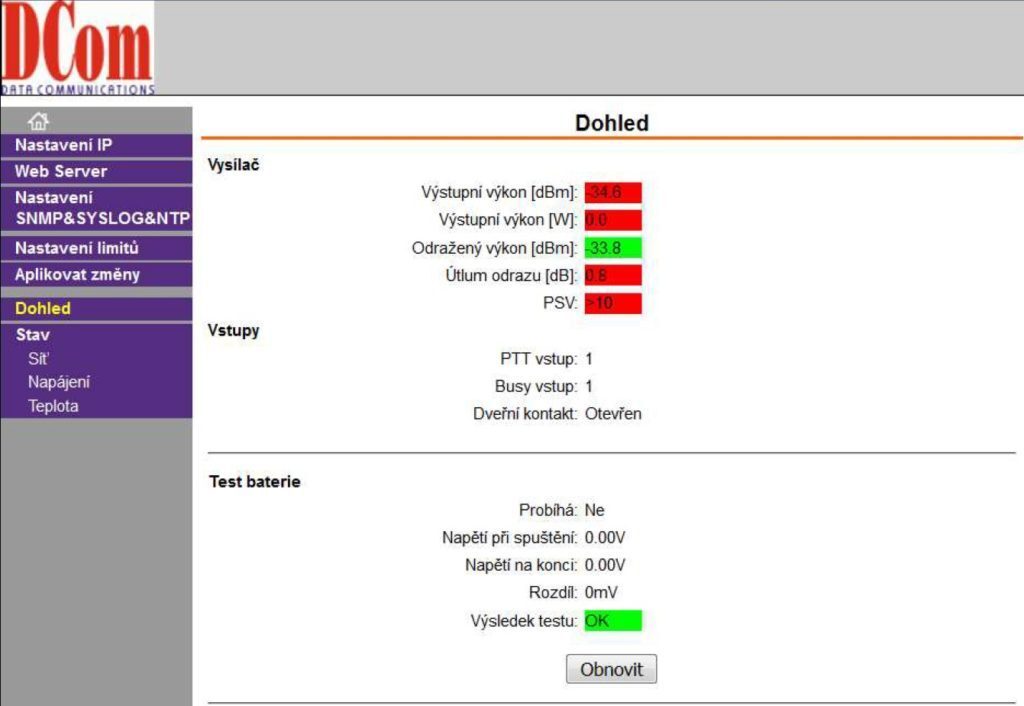Repeaters or other retransmission base stations are key elements of the radio network infrastructure that ensure the communication of professional users of radios over a large area. The communication of radio network participants depends on them. With the use of a repeater, reliable communication over a large area can be ensured compared to direct communication between radios.
Ensuring reliable operation of the radio network repeater
Due to the importance of the repeater for the operation of the radio network, it is necessary to ensure its reliable operation. It is not an easy task. Repeaters are often located in hard-to-reach places. These can be high hills, elevations that allow good signal coverage of the radio network of the area. It is important for the radio network administrator to have an overview of the correct function of the repeater. In the event of a fault, it is then important to have information on which base station parameter does not have the required parameters. Based on this information, the network administrator can select the components and the repair procedure.
Radio network infrastructure under supervision
All radio network repeaters can be monitored in a single environment. The radio network administrator is notified of faults or deviations from the parameters from the set limits. Individual parameters can be monitored over time.
DS261 power supply and monitoring equipment
Based on the requirements of our customers of radio network users, our company decided to develop and manufacture a special power supply and monitoring equipment for radio network repeaters. DS261 serves for monitoring and control of repeaters in the VHF and UHF bands. The device contains an integrated 13.8 V / 150 W power supply, which allows to supply up to 3 radios (2x for the repeater, 1x for data transmission) with a charger and a 12 V battery disconnector. The maximum charging current is 5 A, the disconnect voltage is 10.5 V The power supply is designed for mounting in a 19 “cabinet (rack),
Advantages of using a power supply and monitoring equipment
- Universal use for analog and digital repeaterss of various manufacturers
- Antenna system check (SWR measurement not affected by duplexer)
- Measurement and control of repeater output power
- Measurement and control of power supply parameters, including battery stress test
- Possibility to set levels of individual parameters for automatic warning
- Possibility of device integration into the SNMP monitoring system
- Transmission of information via computer or GSM network
- Intuitive web interface for checking parameters and settings
Monitored parameters and equipment
Surveillance equipment measures AC mains supply voltage 230 V, internal DC supply voltage 13.8 V, 5 V and 3.3 V, internal temperature, transmitted power (max. 20 W), reflected power and SWR of the antenna system. The measured parameters are available via the web interface and possibly also sent via the SNMP protocol to the monitoring server. DS261 power supply contains a real time clock (RTC) circuit with the possibility of synchronization with an NTP server. Busy, External PTT and PTT Sense signals must be fed from the repeater for proper supervision.
Battery stress test
The DS261 monitoring device allows you to remotely perform a battery load test, disconnecting the 230 V supply voltage, keying the repeater and measuring the battery voltage. At the end of the set interval (default 10 s), it reconnects the supply voltage and displays information about the voltage at the beginning and end of the test and the difference between these voltages via the web interface. When the set difference (default 1700 mV) is exceeded, it signals an error. To prevent the supervision from being switched off unintentionally, the voltage at which the test is interrupted can be set (default 11.5 V). All parameters can be changed via the web interface. The battery test is performed automatically at a set interval, or can be run manually via the web interface.
Connecting the DS261 to a computer network
The DS261 monitoring device can be connected to the LAN using two equivalent ports ETH 1 and ETH 2 (supervision includes an internal switch), in case of unavailable network connection a GSM modem is supplied, which is powered directly from the supervision by the backup voltage. The DS261 also allows the connection of a door contact that monitors the opening of the cabinet (rack) with the technology.
Basic technical parameters
| Dimensions | 19 “module height 9 cm (2U) and depth 17 cm (without connectors), width (without holders) 44 cm |
| Mass | 4 kg |
| Dust and water protection | IP20 |
| Operating temperature range | 0 to 45 ° C |
| Storage temperature range | -20 to 60 ° C |
| Humidity | 20 to 90%, non-condensing |
| Input voltage rated | 230 V ± 10%, 50 Hz, max. 2 A |
| Maximum output HF power | 20 W |
| Connecting connectors | |
| LAN (Ethernet) – | 2 × RJ45 |
| 230 V supply – | EURO forks |
| RDST power supply, modem, battery connection | fork Tyco 1-350345-0, sockets 1- 350344-0 including pins are included |
| Repeater connection | D-Sub 9 Male |
| AUX connection (door contact) | D-Sub 9 Female |
| Antenna + repeater | N female |









